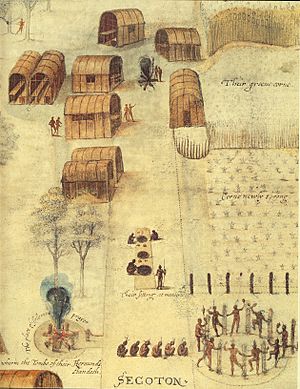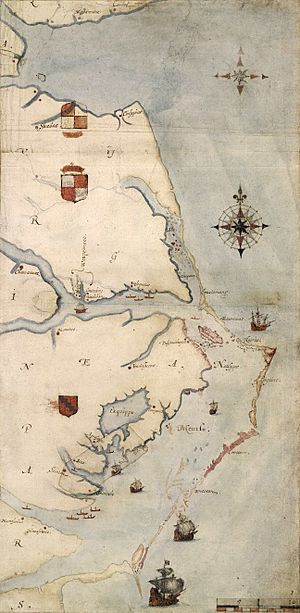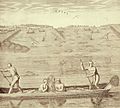John White (colonist and artist) facts for kids
Quick facts for kids
John White
|
|
|---|---|

The return of Governor White to the "Lost Colony"
|
|
| Born |
John White
c. 1539 London, England
|
| Died | 1593 (aged 53–54) Location unknown, possibly County Cork, Ireland
|
| Known for | Painting, drawing, discovering Roanoke Island, losing the lost colony |
| Spouse(s) | Tomasyn Cooper (m. c. 1566) |
| Patron(s) | Sir Walter Raleigh |
John White (born around 1539, died around 1593) was an English explorer, artist, and mapmaker. He also served as a colonial governor. White sailed with the first group that tried to settle Roanoke Island in 1585. His job was to draw pictures and maps for the trip.
He is most famous for being the governor of the second attempt to start a colony on Roanoke Island in 1587. This colony later became known as the "Lost Colony" because all the settlers mysteriously disappeared.
While on Roanoke Island, White created many watercolor drawings. These pictures showed the land and the native Algonkin people living there. His drawings are very important because they are some of the best early images of Native American life on the Eastern coast of America. The original drawings are now kept in the British Museum.
In 1587, White became the governor of Sir Walter Raleigh's plan for a permanent settlement on Roanoke Island. This was the first major effort by England to create a lasting colony in the New World. White's granddaughter, Virginia Dare, was the first English child born in the Americas.
After the colony failed, White moved to Raleigh's land in Ireland. He often thought about the "unfortunate events" that ruined his dreams in America. Still, he never gave up hope that his daughter and granddaughter were alive.
Contents
Early Life of John White
We don't know the exact date John White was born, but it was likely between 1530 and 1540. He lived in London and married Tomasyn Cooper in 1566. They had a son named Thomas, who died young, and a daughter named Eleanor. We don't know much about how White learned to be an artist. He might have trained as an illustrator in London.
White's Career as an Explorer and Artist
In the late 1500s, England became very interested in starting colonies in the New World. John White was excited about these plans. In 1585, he joined an expedition led by Sir Ralph Lane. This group tried to set up the first English colony in North America.
Sir Walter Raleigh sent White as an artist and mapmaker on this trip. White worked closely with a scientist named Thomas Harriot. The expedition faced many problems and returned to England in 1586.
John White's Amazing Artworks
In 1585, White was asked to "draw to life" the people and places of the New World. During his time on Roanoke Island, he made many watercolor drawings of the land and the native people. These drawings are very important. They show us what Native American societies on the Eastern coast looked like. They are the only visual records we have from England's first settlers in America.
White's love for watercolor painting was unusual for his time. Most artists preferred oil-based paints. But White's watercolors quickly became famous in Europe. A Flemish artist named Theodore de Bry made engravings (prints) from White's drawings. These prints were published in 1590 in a book called America. This helped spread White's images far and wide.
Governor of the Roanoke Colony
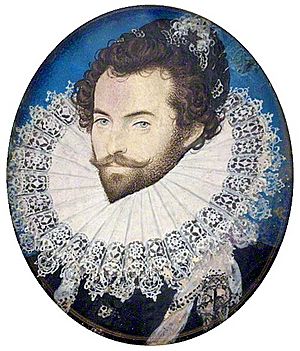
After the first group of colonists returned to England in 1586, Sir Walter Raleigh decided to try again. He wanted a new settlement in the Chesapeake Bay area. This new colony would be able to support itself and would include women and children. In 1586, White convinced 113 people to join Raleigh's new trip. Among them were his daughter, Eleanor Dare, and his son-in-law, Ananias Dare.
Raleigh rewarded White for his hard work. On January 7, 1587, Raleigh named "John White of London Gentleman, to be the chief Governor" of the new colony.
Arrival at Roanoke Island
In May 1587, White's colonists sailed for Virginia on a ship called the Lion. Their guide was a Portuguese sailor named Simon Fernandez. The settlers planned to go to Chesapeake Bay, not Roanoke. But when they reached Roanoke in late July, Fernandez refused to let White's men get back on the ship.
White's journal says that Fernandez told the sailors not to take any settlers back. He said they should leave them on the island. White had to agree to this sudden change of plans. Fernandez claimed that "summer was farre spent" (summer was almost over) and he would not land the settlers anywhere else.
The second Roanoke colony began fixing the buildings left by the 1585 group. They also looked for the fifteen men left behind by the earlier expedition, but only found bones. At first, things went well with the local Algonkin Indians. White quickly met friendly natives led by Chief Manteo. Manteo explained that the lost fifteen men had been killed by hostile Secotan, Aquascogoc, and Dasamongueponke warriors.
However, on August 8, 1587, White led an attack on the Dasamongueponkes that went wrong. White and his soldiers attacked the village early in the morning, but they mistakenly attacked a group of friendly Indians. They killed one and wounded many. White wrote in his journal, "We were deceaved, for the savages were our friendes." After this, relations with the local tribes got worse.
Virginia Dare is Born
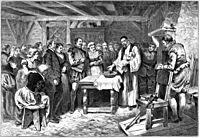
On August 18, 1587, there was happy news for White. He became a grandfather! His daughter Eleanor gave birth to a baby girl on Roanoke. The baby was healthy and was christened (baptized) the next Sunday. Because she was the first Christian child born in Virginia, she was named Virginia.
White Returns to England for Supplies
Soon, the colonists started running low on food. In late 1587, the settlers asked White to return to England. They needed him to get more supplies and other important things. Since the colony was dropped off at Roanoke instead of Chesapeake Bay, supply ships from England might not find them. The settlement might not survive the winter.
White did not want to leave his colony. He worried that his enemies in England would "slander [him] falsely" if he left. He also worried his belongings would be stolen or ruined. But the colonists promised to protect his things. So, "much against his will," he agreed to sail back to get help.
White's trip back to England was full of bad luck from the start. The ship's anchor got stuck, and many crew members were hurt trying to raise it. Their journey was also delayed by bad winds and a big storm. Many sailors starved or got sick with scurvy. On October 16, 1587, the desperate crew finally landed in Ireland. White then made his way back to Southampton, England.
The Spanish Armada Threat
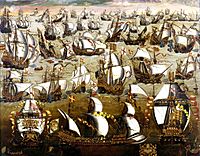
More bad news waited for White in England. Just two weeks earlier, Queen Elizabeth I had stopped all ships from leaving English shores. The reason was a huge fleet of ships built by the King of Spain, with help from the Pope. This was the "invincible fleetes" – the Spanish Armada – planning to invade England. White's patron, Sir Walter Raleigh, tried to get ships to rescue the colony, but the Queen would not allow it.
=Brave and the Roe
In early 1588, White managed to find two small ships, the Brave and the Roe. These ships were not good enough for military use, so they could be used for the Roanoke trip. But they were barely suited for crossing the Atlantic Ocean. White had more bad luck when French pirates attacked his ships. The pirates "playd extreemely upon us with their shot," even hitting White in his side. White and his crew escaped with their lives, but the pirates "robbed us of all our victuals, powder, weapons and provision." The trip to Virginia had to be canceled. By this point, White felt like he was born under "an unlucky star."
Return to the "Lost Colony"
Finally, in March 1590, the threat of a Spanish invasion was over. Raleigh was able to send White's rescue expedition. Two ships, the Hopewell and the Moonlight, sailed for Roanoke. The journey back was long because of many privateering (pirate-like) attacks and sea battles. White's landing at the Outer Banks was also dangerous due to bad weather and strong currents. Seven of the sailors who went with White drowned during the landing.
Governor White finally reached Roanoke Island on August 18, 1590, which was his granddaughter's third birthday. But he found his colony had been empty for a long time. The buildings had fallen apart, and "the houses [were] taken downe." The only clues about where the colonists went were the letters "CRO" carved into a tree. The word "CROATOAN" was carved on a post of the fort. Croatoan was the name of a nearby island (now Hatteras Island) and a local Native American tribe.
Roanoke Island was not the original planned location for the colony. The settlers had talked about moving somewhere else. Before White left, he and the colonists agreed that if they moved, they would carve a message into a tree. If they were forced to move, they would also carve a Maltese Cross. White did not find a cross, so he hoped his family was still alive.
The colonists had kept White's belongings safe, burying them carefully. However, local Indians had found the hiding place and looted it. White found "many of my things spoyled and broken, and my books torne from the covers, the frames of some of my pictures and mappes rotten and spoyled with rayne, and my armour almost eaten through with rust."
Because the weather "grew to be fouler and fouler," White had to stop searching nearby islands for the colonists. The ship's captain had already lost three anchors and could not risk losing another. White returned to Plymouth, England, on October 24, 1590.
The loss of the colony was a very sad event for White. He never fully recovered. He never returned to the New World. In a letter, he wrote that he had to leave the fate of the colonists and his family "to the merciful help of the Almighty."
Later Life and Legacy
We don't know much about John White's life after the Roanoke Colony failed. He lived in Plymouth, England, and also owned a house in Ireland. He seems to have lived on Sir Walter Raleigh's lands, making maps for Raleigh's tenants. He often thought about the "unfortunate events" that ruined his dreams in the New World. But he never stopped hoping that his daughter and granddaughter were still alive.
The last known document written by White is a letter from Ireland in 1593. It was sent to the person who published the prints of his Roanoke drawings.
Today, John White is mostly remembered for his watercolors. They give us a special look at Algonquian society in the 1500s. All of White's surviving artworks are now in the British Museum.
In 2007, the British Museum put all of John White's watercolors on public display. The collection was called "A New World: England's First View of America." There are more than seventy watercolors in this traveling exhibit.
The World War II Liberty ship SS John White was named in his honor.
Images for kids
-
The invincible Spanish Armada, later proved to be vincible


